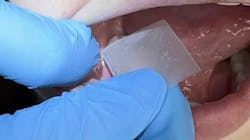The next frontier in prevention is regenerating enamel naturally
Key Highlights
- Subsurface remineralization targets the root cause of early enamel lesions, not just surface damage.
- Hydroxyapatite and amorphous calcium phosphate penetrate enamel to deliver essential minerals deep within tooth structure.
- Dissolvable dental strips provide fluoride and fluoride-free options for in-office and home remineralization care.
- Peptide-based technology like P11-4 creates a scaffold that guides new hydroxyapatite crystal formation.
- Prevention through regeneration represents the next evolution in minimally invasive dental hygiene care.
Dental hygienists pride ourselves on being the frontline heroes of prevention and champions of noninvasive care. We play a critical role in identifying early signs of disease, educating patients, and implementing strategies to keep them out of the restorative chair.
One of the most exciting advances in dental science today is the shift toward biomimetic, targeted therapies that align perfectly with our commitment to preserving natural tooth structure. A prime example is the growing interest in the in situ delivery of hydroxyapatite forming minerals—calcium and phosphate—for subsurface remineralization.
Why subsurface remineralization matters more than surface repair
Many early caries lesions appear sound on the surface but are actively demineralizing underneath. Traditional fluoride-based therapies often treat only the surface, where high fluoride concentrations seal the lesion and block further diffusion.1
This barrier prevents essential minerals from reaching deeper, porous enamel areas. Without consistent hygiene, these sealed lesions can reopen and allow acid to penetrate and disease to progress. That’s why subsurface targeted therapies are so promising. They address the root cause, not just surface symptoms.
Recent scientific advancements show that less polar, positively charged materials like hydroxyapatite (HAP), fluorohydroxyapatite, and amorphous calcium phosphate (ACP) can penetrate enamel porosities and deliver minerals precisely where needed.1-3 Traditional fluoride and other common toothpaste ingredients lack a driving force to reach these subsurface areas, resulting only in superficial repair that may later “reactivate.”
Mineral-loaded particles mimic natural enamel formation, traveling through porous lesions to release calcium and phosphate ions deep within, forming hydroxyapatite in situ.2 This targeted remineralization halts progression and enhances esthetics.
Greenmark’s CrystLCare Biorestorative dental strips exemplify this innovation. They are dissolvable dental strips designed to deliver bioavailable calcium and phosphate directly into enamel pores and dentinal tubules.2 Available as fluoride-free for home use and fluoride-containing for in-office application, these strips offer versatility for patients and clinicians alike. The fluoride-free option is great for those sensitive to or avoiding fluoride, while the fluoride-containing version is FDA cleared for sensitivity treatment.2
What makes these strips unique is their use of submicron starch-based particles loaded with mineral ions that are targeted to porous enamel and accessible dentinal tubules. When applied, the strip dissolves in saliva within three minutes, releasing these particles.2
Natural salivary enzymes degrade the starch, releasing bioavailable calcium and phosphate ions deep within tooth structure, promoting hydroxyapatite formation in situ. This supports enamel repair with more than 25 times more remineralization than fluoride treatment alone, while also providing lasting sensitivity relief.2
How hydroxyapatite dental strips work to rebuild enamel
These strips are ideal pre- and post-prophy or SRP for managing generalized sensitivity and treating incipient caries. They require no special tools, are easy to use, and provide immediate and long-term relief from sensitivity, making them a perfect addition to any preventive protocol. Their biocompatibility and safety mean they can be implemented as part of both in-office treatments and home care routines.
Remineralization is a natural process where calcium and phosphate ions redeposit into tooth structure. Under ideal conditions, these ions realign within the enamel scaffold and rebuild hydroxyapatite crystals. Teeth undergo cycles of demineralization and remineralization throughout the day. Cavitated lesions form when acid attacks cause excessive mineral loss and repair cannot keep up. Modern dentistry allows us to detect lesions before cavitation and strengthen vulnerable areas with preventive strategies like these.
The hydroxyapatite applications fall under the D2991 code for professional application. The fluoride-containing product is FDA cleared for hypersensitivity, confirming safety and efficacy in delivering apatite-forming ions directly into tooth structure for relief and repair. Both fluoride-free and fluoride-containing versions use the same application process but cater to different patient needs.
Research, including in vitro, in situ, and emerging in vivo studies, supports the efficacy of HAP-forming therapies in remineralization and sensitivity relief. Hydroxyapatite products can perform as well or better than traditional fluoride therapies in preventing caries without the risk of fluorosis. These solutions are especially valuable for pediatric patients or those seeking fluoride free options.
New peptide technology offers a biomimetic path to enamel regeneration
While this mineral-loaded delivery system brings us closer to biomimetic repair, it represents just one side of the innovation landscape. Another approach moves beyond ion delivery and focuses on creating a scaffold that actively guides enamel regeneration. Curodont Repair Fluoride-Plus from vVardis and the take-home product Curodont Protect Fluoride-Plus exemplify this innovation, which involves the use of the self-assembling peptide P11-4, indicated for early enamel lesions. In an acidic environment, the peptide unfolds and organizes into a nanofiber scaffold within the demineralized enamel.
This scaffold serves as a framework where calcium and phosphate ions from saliva or topical agents can nucleate and grow new hydroxyapatite crystals directly inside the lesion. The process mimics natural amelogenesis by guiding hydroxyapatite deposition, which is why it’s described as biomimetic remineralization.
P11-4 promotes the regeneration of enamel-like minerals. Fluoride alone primarily drives the conversion of existing crystals into fluorapatite, improving resistance to acid but not fully restoring the prism structure. This is why traditionally remineralized areas may remain chalky, opaque, or porous.
In contrast, within three to six months, P11-4 can regenerate the crystal network, producing some visible changes that more closely resemble natural enamel in both orientation and hardness. One clinical trial reported that after six months, 80% of caries treated with p11-4 peptides and fluoride became inactive as opposed to only 34% of those treated with fluoride alone.4
Note that P11-4 is not indicated for pitting or fractures and is for enamel surfaces only. For optimal results, sufficient levels of free calcium and phosphate must be present. In cases of xerostomia or inadequate salivary minerals, this biomimetic system is often paired with adjuncts such as CPP-ACP, nanohydroxyapatite, or calcium and phosphate products like CrystaLcare to enhance ion availability and support complete remineralization.
A new standard of care: Prevention through regeneration
We’re entering a new era of dentistry where prevention through regeneration is moving into the spotlight. Soon it will be standard of care not to watch and wait, but to find and treat lesions earlier than ever, preventing patients from entering the restorative cycle.
Dental hygienists are positioned to integrate these innovations into patient care, protecting tooth structure long before restoration is required. Greater emphasis on remineralization treatments must become part of every preventive program. Gone are the days when prevention meant only a fluoride varnish. Complete prophylaxis involves removing hard and soft deposits, detecting early caries, and following up with remineralization agents—all with the goal of preserving natural teeth for a lifetime of health and function.
References
1. Rebecca L, Slayton, RL, Araujo MWB, et al. Evidence-based clinical practice guideline on nonrestorative treatments for carious lesions. JADA. 2018:149(10):837-849. doi:10.1016/j.adaj.2018.07.002
2. Jones NA, Pan LC, Flannagan SE, et al. Targeted enamel remineralization with mineral-loaded starch particles. JADA Found Sci. 2024;3:100041.
3. Maltz M, Leal FL, Wagner MB, et al. Can we diagnose a patient’s caries activity based on lesion activity assessment? Findings from a cohort study. Caries Res. 2020;54(3):218-225. doi:10.1159/000509871
4. Alkilzy M, Tarabaih A, Santamaria RM, Splieth CH, Self-assembling Peptide P11-4 and fluoride for regenerating enamel. J Dent Res. 2018;97(2):148-154. doi:10.1177/0022034517730531
About the Author

Rachel Miller, AS, RDH
Rachel is a consultant, educator, speaker, and author who specializes in integrating emerging technologies into dental hygiene practice. She focuses on clinical training, noninvasive technologies, and evidence-based continuing education. Passionate about advancing the profession through innovation and lifelong learning, Rachel emphasizes the oral-systemic connection and the role of hygienists in transforming patient care. She is co-owner of RDH Care in Focus and is currently completing her BS and MS in dental hygiene at the University of Michigan. Rachel is an active member of AADH, ADHA, ADEA, DeW, and MDHA.

Shelley Brown, MEd, BSDH, RDH
Shelley is a dental educator, speaker, content creator, and mobile clinician dedicated to advancing accessible and innovative dentistry. As co-owner of HYGIENE edgeUCATORS, she empowers dental educators through professional development. Since 2009, she has taught at the Utah College of Dental Hygiene and founded Homebound Smiles, a mobile dental practice serving underserved patients. She also runs Shelley.Dental, a YouTube and TikTok platform focused on patient education and minimally invasive dentistry.
